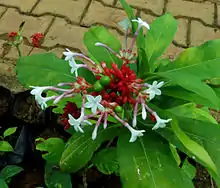| Rauvolfia serpentina | |
|---|---|
 | |
| Scientific classification | |
| Kingdom: | Plantae |
| Clade: | Tracheophytes |
| Clade: | Angiosperms |
| Clade: | Eudicots |
| Clade: | Asterids |
| Order: | Gentianales |
| Family: | Apocynaceae |
| Genus: | Rauvolfia |
| Species: | R. serpentina |
| Binomial name | |
| Rauvolfia serpentina | |
| Synonyms[3] | |
| |
Rauvolfia serpentina, the Indian snakeroot, devil pepper, or serpentine wood,[4] is a species of flower in the milkweed family Apocynaceae.[5] It is native to the Indian subcontinent and East Asia (from India to Indonesia).[6][7]
Rauvolfia is a perennial undershrub widely distributed in India in the sub-Himalayan regions up to 1,000 metres (3,300 ft).
Chemical composition
Rauvolfia serpentina contains dozens of alkaloids of the indole alkaloid family, including ajmaline, ajmalicine, reserpine, and serpentine, among others.[5][8]
Research
A 2016 review found that reserpine reduced systolic blood pressure (SBP) by about 8 mmHg compared to placebo, and may be as effective at reducing SBP as other front-line hypertensive drugs, although more research is needed to determine a dose-specific safety profile.[9]
Potential adverse effects
R. serpentina may cause adverse effects by interacting with various prescription drugs[10] or via interference with mechanisms of mental depression or peptic ulcer.[10] The reserpine in R. serpentina is associated with diverse adverse effects, including vomiting, diarrhea, dizziness, headache, anxiety, or hypersensitivity reactions.[5]
Gallery
 Flower
Flower Flowers and leaves
Flowers and leaves Maturing flower
Maturing flower
See also
References
- ↑ "Appendices". Convention on International Trade in Endangered Species (CITES). 2014. Retrieved 2014-08-07.
- ↑ "Rauvolfia serpentina". US Department of Agriculture, Agricultural Research Service. 1992-2016. Dr. Duke's Phytochemical and Ethnobotanical Databases. 10 September 2018. Retrieved 25 November 2018.
- ↑ "The Plant List: A Working List of All Plant Species". Royal Botanic Gardens, Kew, UK and Missouri Botanical Garden. Retrieved 12 April 2015.
- ↑ USDA, NRCS (n.d.). "Rauvolfia serpentina". The PLANTS Database (plants.usda.gov). Greensboro, North Carolina: National Plant Data Team. Retrieved 19 October 2015.
- 1 2 3 "Rauwolfia serpentina root". DrugBank, Canadian Institutes of Health Research. 2 November 2018. Retrieved 25 November 2018.
- ↑ eFloras. "Rauvolfia serpentina". Flora of China. Missouri Botanical Garden, St. Louis, MO & Harvard University Herbaria, Cambridge, MA. Retrieved 9 April 2012.
- ↑ Oudhia, P. and Tripathi, R.S. (2002). Identification, cultivation and export of important medicinal plants. In Proc. National Seminar on Horticulture Development in Chhattisgarh: Vision and Vistas. Indira Gandhi Agricultural University, Raipur (India) 21-23 Jan. 2002:78-85.
- ↑ Srivastava, A.; Tripathi, A. K.; Pandey, R.; Verma, R. K.; Gupta, M. M. (2006). "Quantitative determination of reserpine, ajmaline, and ajmalicine in Rauvolfia serpentina by reversed-phase high-performance liquid chromatography". Journal of Chromatographic Science. 44 (9): 557–60. doi:10.1093/chromsci/44.9.557. PMID 17059683.
- ↑ Shamon, Sandy D.; Perez, Marco I. (2016-12-21). "Blood pressure-lowering efficacy of reserpine for primary hypertension". The Cochrane Database of Systematic Reviews. 2016 (12): CD007655. doi:10.1002/14651858.CD007655.pub3. ISSN 1469-493X. PMC 6464022. PMID 27997978.
- 1 2 "Rauwolfia serpentina (drug interactions)". Drugs.com. 1 November 2018. Retrieved 25 November 2018.